Punjab - Tourism - Heritage
Forts and Palaces Historical Remains
Sheesh Mahal, Patiala
Maharaja Narendra Singh was a great patron of literature, music and fine arts. He invited many painters from Kangra and Rajasthan to paint the walls of Sheesh Mahal.

Their works depicting the vision in poetry of Keshav, Surdas and Bihari, both in line and colour, are a treat to the eye of the beholder. The themes of these paintings embrace mythology, legends, Raga-Ragni, Nayak-Nayika and Bara-masa in Rajasthani style. These walls and ceilings are also rich in floral designs. The interior casts a Kaleidoscope phantasmagoria of myriad images and multi-coloured lights. The museum has a rich collection of miniature paintings of the middle of 19th century. Themes of these paintings are based on the Geet Gobinda or Jaya Deva's poetry. The Kangra paintings depicting the, Krishan Lila reflect the highest professional and delicate taste. Paintings displaying the Raga-mala of the Rajasthan schools and that of the Mughal give a visual meaning to the Ragas.
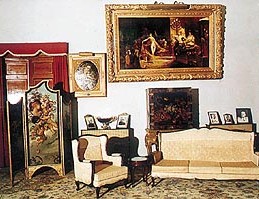
Besides miniature paintings, there are fine objects of Tibetan art particularly the sculpture of different kinds of metals. Ivory carvings of Punjab, royal wooden carved furniture, and a large number of Burmese and Kashmiri carved objects are also exhibited. One can see the huge portraits of the rulers of Patiala adorning the walls of museum hall. Some of the rare manuscripts can be seen here. Beside Janamsakhi and Jain manuscripts, the most valuable possession is the Gulistan-Bostan by Sheikh Sadi of Shiraz, which was acquired by the Mughal Emperor Shah Jahan for his personal library.
Quila Androon, Patiala
The Qila (fort) was also the residence of Patiala dynasty. The residential part was called Qila Androon or the Inner Fort. Its living apartments have names like Jail Walla Palace for royal prisoners, the Moti (pearl) Palace, the Sheesh (mirror work) Palace, the Rajmata (Queen Mother) Palace, the Palace of Colours, the Palace of the Moon. The recreational structures were called the Putli (Puppet) Ghar and Bagh Ghar or the Garden House. Its richly painted chambers are peerless.
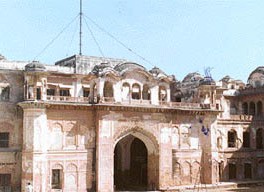
Most astonishing of all, the Palace is fitted with underground sewerage system and has a cool room connected with a tunnel which brings cool air from the basement. Lassi Khana-the royal kitchen used to feed 35,000 people of all ranks everyday.
Gobindgarh Fort, Amritsar
The fort was designed build during early 19th century by Maharaja Ranjit Singh. this fort has certain unique architectural features like western style barracks on four corners and a palace in the centre.
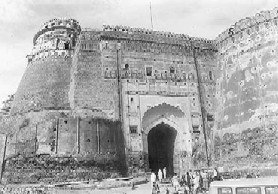
It has a wide circular inspection gallery around the fort having an additional fort wall in between the outer water moat and the main fort-walls. It also has underground escape outlets and inlets with fortifications. This fort was mainly used as a treasury of the Sarkar-e-Khalsa and is the only Sikh fort with the longest history.
Bathinda Fort
There is an ancient fort which has been in existence for the last 1800 years . It was here that Razia Sultan, the first woman to take charge of the Delhi throne was incarcerated on her defeat and dethroned.
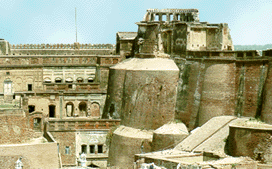
The bricks of the fort date back to Kushana period when emperor Kanishka ruled over India. Schooner shaped fort stands like a ship in a sea of sand. This design was eminently suited to the desert environment. In 1754 AD it was captured by Maharaj Ala Singh of Patiala. A small gurdwara commemorates the visit of Sri Guru Gobind Singh Ji here.
Faridkot Fort
30 Km south of Ferozepur. Reputed to be 700 years old, noteworthy for the hall of mirrors and wall paintings called Sheesh Mahals these halls of mirrors were copied in Rajasthan style and were actually the prayer rooms of the ruling family. Palace has remarkable paintings, mirror - work and frescoes designed all over their walls.

Qila Mubarak, Patiala
Founded in1764 by Maharaja Ala Singh. It was originally a kuchi-garhi of a mud fort which was later raised into a sprawling double storied structure with a massive gate having beautiful arches. It has two portions, Qila Androon, the inner fort, Qila Mubarak the outer.
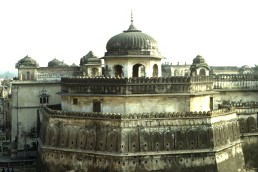
The facade of gate of Qila Androon is decorated with geometrical and floral designs in lime plaster. There are two painted chambers depicting scenes tom Hindu mythology and portraits of Sikh Gurus in Patiala style. The complex has a unique under-ground sewerage system. An excellent museum of Chandeliers and famous weapons is located here.
Bahadurgarh Fort
6 kms from Patiala, originally founded by Nawab Saif Khan in 1658. The present fort was built by Maharaja Karam Singh of Patiala in 1837. It has two circular ramparts and is surrounded by a moat and covers an area of 2100 sq meters.
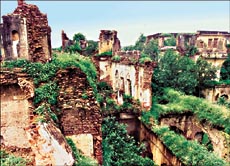
The circumference of the fort is around 2 km. There is also a historical Gurudwara known as Sri Gurudwara Sahib Patshai Nauvin built in the sacred memory of Guru Teg Bahdur who stayed here for three months and nine days before going to Delhi for martyrdom.
Anandpur Fort
Picturesquely set against the Naina Devi ranges, this brick fort was built by Guru Gobind Singh Ji, the tenth Sikh Guru. Some traces of which are still extant.
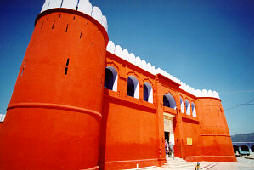
There is a wide well on a lower level of the hill. It is called Baoli Sahib. A covered passage with 135 steps leads down to its water level.
Phillaur Fort
It was designed by Dewan Mohkam Chand,the brave general of Maharaja Ranjit Singh facing the, then, British border along Ludhiana.

Its on the banks of Sutlej river. It is rendered very conspicuous by its large barbican. It was an important artillery arsenal and magazine up to the time of great uprising of 1857 and had a detachment in garrison, which however kept there.
Forts and Palaces Historical Remains